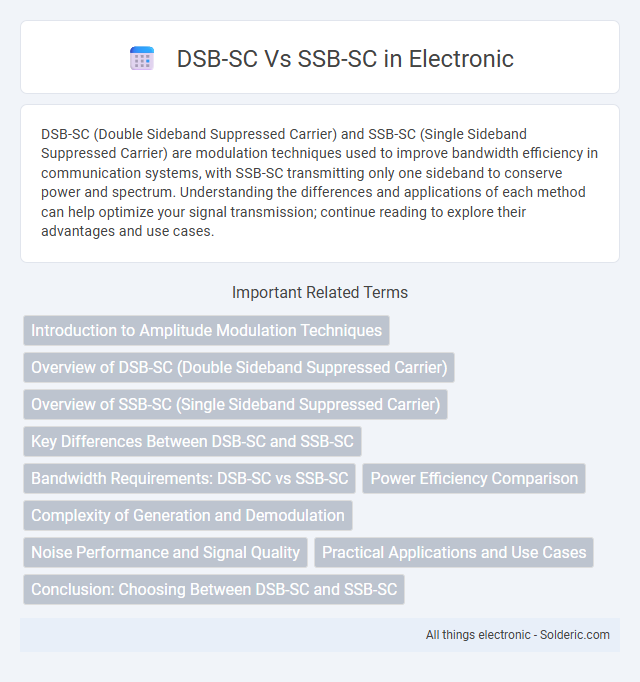DSB-SC (Double Sideband Suppressed Carrier) and SSB-SC (Single Sideband Suppressed Carrier) are modulation techniques used to improve bandwidth efficiency in communication systems, with SSB-SC transmitting only one sideband to conserve power and spectrum. Understanding the differences and applications of each method can help optimize your signal transmission; continue reading to explore their advantages and use cases.
Comparison Table
| Feature | DSB-SC (Double Sideband Suppressed Carrier) | SSB-SC (Single Sideband Suppressed Carrier) |
|---|---|---|
| Definition | Modulation technique with both sidebands transmitted, carrier suppressed. | Modulation technique with only one sideband transmitted, carrier suppressed. |
| Bandwidth | Twice the baseband bandwidth (2B). | Equal to the baseband bandwidth (B). |
| Power Efficiency | Less efficient due to transmitting both sidebands. | More efficient by transmitting a single sideband. |
| Complexity | Relatively simple transmitter and receiver design. | More complex due to precise filtering and carrier reconstruction. |
| Applications | AM stereo, some analog communications. | Long-distance voice transmission, HF communications. |
| Carrier Transmission | Carrier suppressed to save power. | Carrier suppressed and one sideband transmitted. |
Introduction to Amplitude Modulation Techniques
Double Sideband Suppressed Carrier (DSB-SC) and Single Sideband Suppressed Carrier (SSB-SC) are amplitude modulation (AM) techniques that improve bandwidth efficiency by suppressing the carrier signal. DSB-SC transmits both upper and lower sidebands, doubling bandwidth usage compared to the baseband signal, while SSB-SC further enhances efficiency by transmitting only one sideband, reducing bandwidth by half. These techniques are essential in communication systems to optimize power and spectral resources for effective signal transmission.
Overview of DSB-SC (Double Sideband Suppressed Carrier)
Double Sideband Suppressed Carrier (DSB-SC) is a modulation technique where both sidebands of the carrier signal are transmitted but the carrier itself is suppressed, improving power efficiency. This method conveys the message signal within two mirror-image sidebands around the carrier frequency, each containing the same information. DSB-SC requires coherent detection with a locally generated carrier at the receiver to recover the original message, distinguishing it from standard AM systems.
Overview of SSB-SC (Single Sideband Suppressed Carrier)
SSB-SC (Single Sideband Suppressed Carrier) is a refined modulation technique that improves bandwidth efficiency by transmitting only one sideband, eliminating the carrier and the redundant sideband present in DSB-SC (Double Sideband Suppressed Carrier). This results in reduced power consumption and better spectral efficiency, making SSB-SC ideal for long-distance communication and applications where bandwidth is limited. Your communication system benefits from enhanced signal clarity and reduced interference with SSB-SC modulation.
Key Differences Between DSB-SC and SSB-SC
DSB-SC (Double Sideband Suppressed Carrier) transmits both sidebands, resulting in higher bandwidth consumption, while SSB-SC (Single Sideband Suppressed Carrier) transmits only one sideband, reducing bandwidth by half. DSB-SC requires simpler modulation but less spectral efficiency; SSB-SC demands more complex filtering but provides better spectrum utilization and reduced power consumption. Your communication system benefits from SSB-SC when bandwidth efficiency and power saving are critical, whereas DSB-SC suits applications needing straightforward implementation.
Bandwidth Requirements: DSB-SC vs SSB-SC
DSB-SC (Double Sideband Suppressed Carrier) modulation requires twice the bandwidth of the original baseband signal because it transmits both upper and lower sidebands. SSB-SC (Single Sideband Suppressed Carrier) modulation effectively halves the bandwidth requirement by transmitting only one sideband, making it more spectrum-efficient. Choosing SSB-SC can optimize your system's bandwidth utilization, especially in bandwidth-limited communication channels.
Power Efficiency Comparison
DSB-SC (Double Sideband Suppressed Carrier) and SSB-SC (Single Sideband Suppressed Carrier) differ significantly in power efficiency; SSB-SC transmits only one sideband, reducing bandwidth and power consumption by approximately half compared to DSB-SC. In DSB-SC, power is split equally between the upper and lower sidebands, making it less efficient for long-distance communication where power and bandwidth are critical. SSB-SC improves power efficiency by concentrating transmitted power into a single sideband, enhancing signal strength and reducing transmission costs.
Complexity of Generation and Demodulation
DSB-SC (Double Sideband Suppressed Carrier) modulation involves simpler generation and demodulation processes due to the straightforward multiplication of the message signal with a carrier, enabling easier envelope detection techniques when synchronized with the carrier signal. In contrast, SSB-SC (Single Sideband Suppressed Carrier) requires more complex generation methods, such as the use of a balanced modulator combined with a phase-shift network or filters to eliminate one sideband, and demodulation demands precise carrier recovery and filtering to avoid distortion and maintain signal integrity. The increased complexity of SSB-SC is justified by its reduced bandwidth and improved power efficiency compared to DSB-SC.
Noise Performance and Signal Quality
DSB-SC (Double Sideband Suppressed Carrier) and SSB-SC (Single Sideband Suppressed Carrier) modulation techniques differ significantly in noise performance and signal quality. SSB-SC offers superior noise immunity by transmitting only one sideband, reducing bandwidth and minimizing susceptibility to adjacent channel interference, which enhances signal clarity. Your communication system benefits from improved signal-to-noise ratio and bandwidth efficiency using SSB-SC, whereas DSB-SC struggles with redundant sideband noise that can degrade overall signal quality.
Practical Applications and Use Cases
DSB-SC (Double Sideband Suppressed Carrier) is widely used in analog communication systems such as AM transmitters and shortwave broadcasting where bandwidth efficiency is less critical. SSB-SC (Single Sideband Suppressed Carrier) excels in long-distance and HF radio communications, enabling more efficient use of bandwidth and power, essential for maritime and aviation applications. Your choice between DSB-SC and SSB-SC depends on the need for spectrum efficiency and power conservation in practical communication scenarios.
Conclusion: Choosing Between DSB-SC and SSB-SC
DSB-SC (Double Sideband Suppressed Carrier) and SSB-SC (Single Sideband Suppressed Carrier) both offer efficient bandwidth usage in amplitude modulation, but SSB-SC is more spectrum-efficient and reduces power requirements by transmitting only one sideband. DSB-SC is simpler to implement and suitable for systems where bandwidth is less constrained. Choosing between these modulation schemes depends on trade-offs between complexity, bandwidth efficiency, and power consumption, with SSB-SC favored in long-distance or bandwidth-critical communications.
DSB-SC vs SSB-SC Infographic

 solderic.com
solderic.com